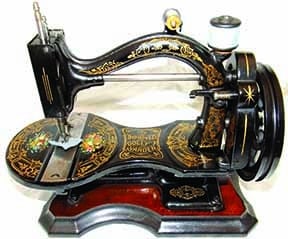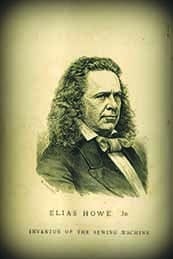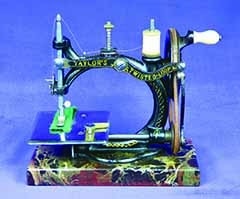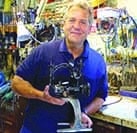By Alex Askaroff
Alex Askaroff is the enthusiastic founder of sewalot.com, a wildly popular website for all things sewing-machine related and officially named the number one antique sewing machine website.
With millions of visitors, his enterprise is noted for its extreme depth of information and ease (and great humor) with which the information is disseminated. As one fan said, “Alex, in a sea of bland, boring sewing machine websites, Sewalot stands head and shoulders above the rest, with real stories, history, information and tales.”
He has an extensive collection of 19th century antique sewing machines, has around 35,000 customer “from boot-patchers, to sail makers, plus all those happy quilters…”, and is a long term member of the Guild of Master Craftsmen. He was trained by experts from Jaeger and spent ten years on the factory floor at the family firm before starting his own business.
Who invented the sewing machine? It is a question I am often asked in my profession. Let me take you on a brief and fascinating tour of one of the most useful inventions of the 19th century.

So how did it all begin? First of all I want you to read a quote from one of the first sewing machine pioneers, James Edward Allen Gibbs. James was the son of a Shenandoah farmer and witnessed all the major developments of the sewing machine. In 1901 he was an old man and interviewed about his inventions and patents. No other person alive was better qualified to quote on the subject. His words are absolutely crucial in understanding the development of the sewing machine.
“No useful sewing machine was ever invented by one man; and all first attempts to do work by machinery, previously done by hand, had been failures. It was only after several able inventors had failed in their attempts, that someone with the mental powers to combine the efforts of others, with his own, at last produced a practicable sewing machine.”
Sewing machine manufacture started slowly and was constantly interrupted. However in the 50 years from 1846 to 1896 the sewing machine went from a circus attraction to a necessity for every household. The Victorian era, with its massive expansion in industry and technology proved to be the fertile ground in which the sewing machine grew. Let’s find out where it all started.
The first mention of mechanical sewing was in England in 1755. Charles Weisenthal was German but while living in England he took out a patent for a needle to be used for “mechanical sewing”. Unfortunately what sort of mechanical sewing we do not know for a description of the machine was not properly mentioned in his patent.
In 1790, once more in England, Thomas Saint really cracked it. Not only did he patent a sewing machine but also he provided enough plans so that a replica could be built and, once modified, stitch. British Patent No. 1764 was awarded to the London cabinetmaker. Due to other patents he filed dealing with leather, the patent was with “Glues & Varnishes” and not discovered until 1873 when the British sewing machine pioneer, Newton Wilson, came across it while researching the history of the sewing ‚machine.
In 1804 we go to France where Thomas Stone had patented a machine that we know little about. That must have been a good year as we have two other gentlemen on the scene, a James Henderson and a canny Scotsman, Mr. Duncan, who had plans for an embroidery machine. Again, nothing has ever come to light about their machines.
Around 1810, Balthasar Krems came up with a unique sewing machine which he used to sew the seams of caps he was manufacturing. His sewing machine was pedal operated and sewed a continuous-circular chain-stitch. There is one of his machines at the Eifel museum in Mayen, Germany, and another replica at the Deutsche Museum in Munich. Because old Balthasar did not patent his design we cannot be sure of the exact dates, but we do know he was German, yavol!
Now we travel across the border to the land of schnitzel and lederhosen, Austria. The year is 1814, Napoleon is about to meet his Waterloo and Josef Madersperger, a humble tailor is building the first of several machines. Although he had been working on his machine since 1807 it was not until 1815 that he was granted patent rights. He tried in vain for years to get his machine right and in 1839 he almost cracked it. In 1841 his machine was awarded a bronze medal but he could not find a manufacturer produce it. Josef had invested every penny in his invention and spent his life working on it. However he was still making the same old mistake that many early pioneers made, which was trying to make his machine copy the hand movement of sewing girls.
Eventually Josef gave his model away and a few years later, in 1850, he died a pauper in the poor house in Vienna. He is still held by the Germans as the inventor of the sewing machine.

In 1818 John Knowles and his partner, John Adams Doge, made a sewing machine and it really stitched! But there is a catch! The machine will only stitch a few inches of cloth before it has to be reset.
In 1826, Henry Lye of Philadelphia, Pennsylvania, patented a sewing machine of sorts but fire destroyed the patent office and his invention was lost, so we move on again.
In 1829-30 the first real sewing machine that we know about was born in France. Barthelemy Thimonnier (I’m going to call him Bart as it makes my head hurt spelling his name) took out a patent for a barbed needled to be used in his sewing machine.
Bart’s machine was not a hit with the French tailors. The machine, made mainly of wood, actually worked. In fact it worked so well that he used them to sew uniforms for the French army.
Before long Bart was sewing away with dozens of machines, taking work from the hungry tailors of Paris. We all know what Frenchmen are like when their blood is up, Madame Guillotine was still warm from their revolution. In 1831it all came to a ahead in his workshop at Rue de Sevres where 80 of his wooden machines were busily sewing away. The angry tailors gathered outside Bart’s premises, stormed in and burnt the lot.
Bart fled to England and sold his patents to a company in Manchester but never regained his former success. Although he had made the first reasonable sewing machine it did not stop the old tailor ending up like his Austrian counterpart. Poor old Bart died in poverty in Amplepuis on the 5th of August 1857.
Back in America things are on the boil. In 1834 Walter is in his basement in New York arguing with his daughter about taking work from the poor sewing women. Walter has made a sewing machine that produces a lockstitch. It is a brand new design and works! It even had two spools of thread. However he never patents it and then sold the plans.
Walter was one of the most prolific inventors of his time but nearly always sold his ideas before patenting them and therefore is hardly remembered today.
Walter Hunt will always be remembered not for the sewing machine but for another point in history. He invented the safety pin!
In 1841 Newton and Archibald, back in England, have designed a chain-stitch machine employing an eye-pointed needle, little else is known of the invention.
On 21 February 1842 John James Greenough of Washington DC, patented a sewing machine with a stitch forming mechanism. Patent 2466 was the first ever American patent for a sewing machine. It had a device for presenting work onto a double pointed needle with an eye in the middle! I bet he pricked his fingers a few times!
In 1843, Dr Frank Goulding of Macon, Georgia also created a sewing device but once again he failed to develop it.
In 1844, back in England again, John Fisher patented a lace-making machine that sewed. However, the patent was misfiled and John did not pursue his invention.
Our trail of failure is all going to change when in 1844 a young Massachusetts farmer was about to shake the sewing world. Elias Howe finished his sewing engine in 1844 and had enough money to patent it by 1846. Elias’s machine was a cracker and most sewing machines to this day use some of his principles. 1846 is probably the most important date in the history of sewing and the true birth of the sewing machine.
Elias tried in vain to sell his expensive and weird contraption, it had no takers in America so he traveled to England where his brother, Amasa, had found a possible purchaser. All this ended in tears and a disappointment, Elias headed home broke. On arriving back in America he found things had changed. In his absence sewing machines had hit the big time. Dozens of sewing machine companies had sprung up and many of them were using his patents, including one Mr Singer.
Most of us know the name Singer but few are aware of his amazing story, his rags to riches journey from a little runaway to one of the richest men of his age. The story of Isaac Merritt Singer will blow your mind, his wives and lovers, castles and countless children, all built on the back of one of the greatest inventions of the 19th century.
Now Elias, unlike nearly all the other inventors who gave up, was stubborn and determined. He borrowed money and sued everyone he could, including our most famous sewing machine entrepreneur, Isaac. In 1850 Isaac had won a bet (so he said) to make a better sewing machine than what was available on the market. It was patented in 1851 and changed the world as we know it because it was better than anything else. It was probably Singer that James Gibbs was referring to at the start of our story. The first reliable sewing machine, with a guarantee, had arrived on planet earth.

From this point in history sewing machines settle down and finally we come to the Great Exhibition in London in 1851 where Charles Judkins demonstrated the only British sewing machine. His power driven machine sewed nearly 500 stitches into fabric in one minute.
Time rolls on and as all the patents run out, manufacturers could copy the best ideas without being sued and true mass production followed. The rest as they say is history.
By the late Victorian period the sewing machine had been hailed as the most useful invention of the 19th century releasing women from the drudgery of endless hours of sewing by hand. Factories sprung up all over the world to feed the insatiable demand for the sewing machine. Germany had over 300 factories alone. By the year 1900 over 20 million sewing machines a year were being made. It had become the biggest industry the world had ever seen.
By 1926 The American Patent Office (that had one sewing machine patent in 1842) had over 150,000 different patent models and millions of patents relating to sewing machines.
It is true to say that no single invention had ever been as eagerly accepted by people in all four corners of the planet as the humble, and often overlooked, sewing machine. It is one small machine that silently touches our daily lives and I expect that right now every single reader will be able to see something stitched on a sewing machine, even if they are sitting on it!
-
- Assign a menu in Theme Options > Menus WooCommerce not Found





Related posts: